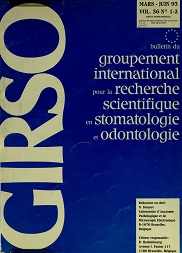S.E.M. observation and profilometer measure of CO2 laser impacts of the dentine
Keywords:
CO2 laser, dentine, scanning electronic microscopy, profilometer measure, adhesionAbstract
The aim of the study was to compare the morphology of craters produced on the dentinal surface by CO2 laser beams (LASERSATtmCO2) before and after the removal of the carbonized layer, besides with different seetings of the power and duration of the laser beam.
Thirty-three recently extracted non carious young third molar teeth were sectionned from vestibular and lingual surfaces, exposing a planed dentinal surface. Twenty impacts were made on each of dentinal surface producing 20 individual craters. The duration and the power of each laser beam were different on each tooth. The duration varied from 0.1 to 0.4 second (0.1 - 0.2 - 0.3 - 0.4 s). The power varied from 1 to 5 watts (1, 2, 3, 4, 5 w).
Specimens obtained for a power of 3 and 4 watts and a duration of 0.1 and 0.2 second were examined with a JEOL 35CF (25 KV, magnification: x 30, x 110, x 200), before and after the removal of the carbonized layer. The carbonized layer of the craters was removed with an air polisher (HEATCO).
Craters obtained for ail duration values as well as for ail power values were analyzed with a profilometer. The chosen profilometer was: TALISURF 10; horizontal amplification Vh = 20; vertical amplification Vv = 200.
Samples were observed by a SEM and the craters depth and diameter were measured with a profilometer. Then, the carbonized layer of the craters was removed with an airpolisher and the cleaned dentinal surface was observed again with the SEM and the profilometer. Measurements were entered in a computer (using the SIPHAR programm) in order to calculate the mean values of the depth, the diameter and the area, for ail test conditions.
It appears that the carbonized layer is not adherent to the dentine and can be easily removed. From the mean values, we can conclude that the diameter is about four times larger than the depth for the nocleaned craters and is about five to six times larger than the depth for the cleaned craters. The profils of the craters cannot be used for retention pins in the composite adhesion but the adhesion area is increased after a laser beam.
Downloads
Published
Issue
Section
License
I hereby certify that the authors of the above manuscript have all:
1. Conceived, planned, and performed the work leading to the report, or interpreted the evidence presented, or both;
2. Written the report or reviewed successive versions and shared in their revisions; and
3. Approved the final version.
Further, I certify that:
1. This work has not been published elsewhere and is not under revision in another journal;
2. Humane procedures have been followed in the treatment of experimental animals (if applicable);
3. Investigations in humans was done in accordance with the ethical standards of the responsible committee on human experimentation or with the Helsinki Declaration (if applicable).
4. This paper has been carefully read by a native English speaker who is familiar with the field of work (this applies to authors who are not fluent in English); and
5. The copyright of the article is transferred from the authors to the Bulletin du Groupement International pour la Recherche Scientifique en Stomatologie et Odontologie upon acceptance of the manuscript.



